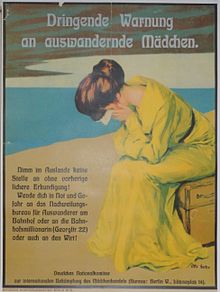The white slave (film series)
The White Slave was a series of silent films initiated in Denmark on the subject of trafficking in girls that was made before the First World War . In particular, the productions made in the early 1910s, which mostly dealt with the dangers of young women traveling abroad, also enjoyed great international popularity. Film historian Michael Esser writes about this: “In addition to the detective series, the White Slave films in Denmark and Germany formed an essential part of trivial cinema, without whose success the expansion of the film industry between 1905 and 1914 would have been much slower and more difficult ". The bases of the stories told in them came from the modern mass medium newspaper; The adventurous colportage stories gained the appearance of credibility through topicality and a reference to reality.
Background, history of origin
On May 18, 1904, an international agreement was signed for the first time, which regulated the trafficking of underage white girls and women abducted by force as a criminal offense. As a result, cinematography, which had hardly been developed until then, began to discover this topic for itself. The first significant result was Den hvide slavinde in 1906 , a film with which the Danish film pioneer Viggo Larsen established the genre of girl trafficking that had been popular for many decades. After another international agreement expressis verbis dealt with the fight against trafficking in girls on May 4, 1910 , this film genre briefly became a series. The great success that the early Sklavin films also had in the German Empire led Larsen to direct a German Sklavin film in the spring of 1911 with The White Sklavin, Part 3 . Other German slave productions followed at irregular intervals, most recently in 1927 a version with Liane Haid in the title role.
Movies
Only those films are listed below that have the words "The White Slave" in the title in Danish or German and can be assigned to this series. Other girl trafficking films such as the silent films The Path That Leads to Damnation (1919) and The Women's Refuge in Rio (1927) are just as neglected in this list as are those productions that dealt with the topic of girl and women trafficking in talkies such as . B. The way to Rio (German Reich 1930), The white slave (L'esclave blanche, France 1939), Export in Blond (Federal Republic of Germany 1950, a remake of The Women's Refuge of Rio ), Girl trafficking (La tratta delle bianche, Italy 1952), mannequins for Rio (1954) and the high-profile Hollywood flick Ashanti from 1978.
| year | German title | Original title | Director | actor |
|---|---|---|---|---|
| 1906 | The white slave | The hvide slavinde | Viggo Larsen | Gerda Jensen |
| 1910 | - | The hvide slave trade | Alfred Cohn | Christel Holch |
| 1910 | The white slave | The hvide slave trade I. | August Blom | Ellen Diedrich |
| 1911 | The white slave II | The hvide slave trade II. | August Blom | Clara Pontoppidan |
| 1911 | The white slave, part 3 | The white slave, part 3 | Viggo Larsen | Wanda Treumann |
| 1912 | Nina, the white slave | Det berygtede hus / Den hvide slavehandel III. | Urban Gad | Lilly Lamprecht |
| 1921 | The white slave, part 1: two oaths | The white slave, part 1: two oaths | Arthur Teuber | Evi Eva |
| 1921 | The white slave, part 2: The silence of the big city | The white slave, part 2: The silence of the big city | Arthur Teuber | Evi Eva |
| 1927 | The white slave | The white slave | Augusto Genina | Liane Haid |
Literature and web links
- Michael Esser: Captivating entertainment. With white slaves to new shores. In: Manfred Behn (Red.): Black dream and white slave. German-Danish film relations 1910–1930 (= A CineGraph book ). Edition Text + Critique, Munich 1994, ISBN 3-88377-483-9 , pp. 55–62.
- White slave in: Lexicon of film terms on filmlexikon.uni-kiel.de
Individual evidence
- ↑ Michael Esser: Captivating entertainment. With white slaves to new shores. In: Manfred Behn (Red.): Black dream and white slave. German-Danish Film Relations 1910–1930 , pp. 55–62
- ↑ a b International agreements against human trafficking. In: humanrights.ch. June 2, 2018, accessed March 17, 2019 .
